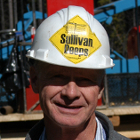A deeper look at the Sully

1 of 2Paul Ransom, P.Geo., did a geological study on the Sully property. — Photo courtesy Scott Broughton2 of 2This is a view of the Sully property lo
1 of 2Paul Ransom, P.Geo., did a geological study on the Sully property. — Photo courtesy Scott Broughton
Located 27 kilometres east of Kimberley, British Columbia, near Fort Steele is the Sully property, a grouping of mineral claims. The property hosts rocks similar to those previously found at the world-class Sullivan deposit at Kimberley, owned by Teck. The property has been held by a group of local prospectors led by Brian Kostiuk of Cranbrook.
Scott Broughton, P.Eng., is the president, CEO and co-founder of Gravitas Metals Corp. Gravitas was specifically organized to explore for and acquire Sullivan-like deposits in the East Kootenay. An option was signed for the Sully late last year.
The Sully property has been the focus of exploration work in the past. A gravity anomaly was initially identified and this led to a drilling program in 2004. Unfortunately, those efforts were based on poorly defined information leading to an assessment that the target was at relatively shallow depth. The results of that program returned a few positive indicators but no discovery.
In 2010, new work organized by the property owners led to an improved interpretation, showing the target was actually deeper than previous drilling. An additional geological study by Paul Ransom, P.Geo. from nearby Wycliffe helped to define the geological similarities to Sullivan and focus the geophysical assessment. Having worked for Cominco at the Sullivan Mine and in the region in general for much of his career, Ransom is a recognized Sullivan geology expert.
Ransom and Excel Geophysics worked to combine geology and gravity survey information to more accurately define mineralization on the property in 2010.
“They made a very strong case for the Sully target, but also highlighted the need for more definition work,” said Broughton. “Gravitas funded new gravity surveys and mapping which resulted in the untested Sullivan-size target outlined on the property now.”
Broughton said that based on a lot of solid exploration work, Gravitas optioned the property in late 2011.
“With the expert work of Ransom, Excel and others, Gravitas has helped to advance the Sully property to the drill-ready stage,” said Broughton. “There is nothing left to do but drill and find out what is there. Although the target is untested—meaning that it is unknown what is actually causing the gravity anomaly until it is drilled—the latest interpretation yields one of the most compelling Sullivan-like targets we have ever seen.”
The opinion is now shared by Cranbrook-based Omineca Mining and Metals Ltd. (TSXv:OMM), who signed an agreement in March 2012 with Gravitas to conduct initial drilling on the property. If drilling is successful, Omineca now has the right to acquire Gravitas and its option on the Sully property.
“Because of its potential size, the discovery of another Sullivan-like deposit would be a story that resonates around the world,” said Broughton. “If initial drilling is successful, it will immediately spawn a larger exploration effort to define the scale of the discovery.”
Broughton said that this development has the potential to have significant economic impact in the Cranbrook and Kimberley region, extending to the Teck smelter in Trail, B.C., and the rest of the province.
“The world-class Sullivan Mine operated for 100 years and produced billions of dollars' worth of important metals,” said Broughton. “Its legacy includes development of much of the regional and provincial infrastructure we now benefit from, in addition to countless jobs, careers and spinoff industries.”




